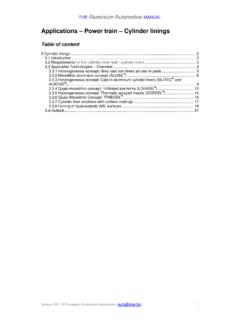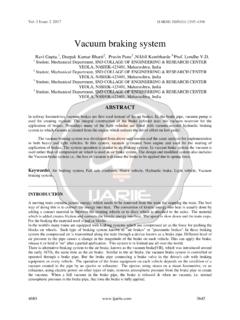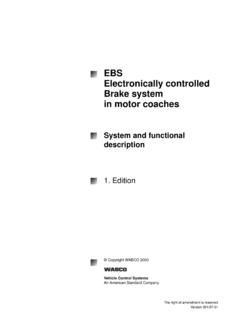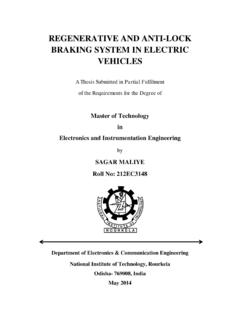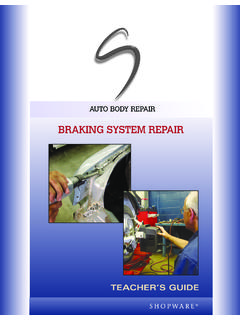Transcription of Applications – Chassis & Suspension – Brake system
1 Applications Chassis & Suspension Brake system Table of Contents 5 Brake 2 2 Aluminium in the braking 4 Components of the braking 6 Disc and 9 Version 2011 European Aluminium Association 1 5 Brake system introduction Automotive Brake systems have been refined for over 100 years and have become extremely dependable and efficient. The Brake system constitutes an integral part of an automobile. It allows the driver to slow or stop the vehicle and prevents a stationary vehicle from moving. Failure of the automobile Brake system can lead to accidents, property damage, physical injuries or even death of an individual.
2 In recent years, Brake systems have undergone tremendous changes in terms of performance, technology, design and safety. Today, anti-lock braking systems (ABS) are more or less standard. Modern ABS versions not only prevent wheel lock under braking , but also electronically control the front-to-rear Brake bias. This function, depending on its specific capabilities and implementation, is known as electronic Brake force distribution (EBD), traction control, emergency Brake assist or electronic stability control system . A further technological step change can be expected with the emergence of the Brake -by-wire technology.
3 Originally, most Brake systems used mechanically actuated drum brakes with internally expanding shoes; the foot pressure exerted on the Brake pedal was carried directly to semicircular Brake shoes by a system of flexible cables. The mechanical brakes, however, were difficult to keep adjusted so that equal braking force was applied at each wheel. Furthermore, as vehicle weights and speeds increased, more and more effort on the Brake pedal was demanded of the driver. Consequently, mechanical brakes were replaced by hydraulic Brake systems. The hydraulic Brake system used in the automobile is a multiple piston system .
4 The Brake pedal is connected to a plunger in the master cylinder, which forces hydraulic oil through a series of tubes and hoses to the braking unit at each wheel. In a disk Brake , the Brake fluid from the master cylinder is forced into a calliper where it presses against a piston. The piston squeezes two Brake pads against the Brake disk, which is attached to the wheel, forcing it to slow down or stop. With drum brakes, the Brake fluid is forced into the wheel cylinder, which pushes the Brake shoes (or pads) outwards so that the friction linings are pressed against the drum. In either case, the friction surfaces of the Brake pads convert the kinetic energy of the vehicle into heat.
5 For increased safety, modern car Brake systems are broken into two circuits, a typical master cylinder includes actually two completely separate master cylinders in a single housing, each servicing two wheels. In order to better control the braking process, additional valves are necessary. Many cars are equipped with drum brakes on the rear wheels and disc brakes on the front. Drum brakes have more parts than disc brakes and are harder to service, but they are less expensive to manufacture, and they easily incorporate an emergency Brake mechanism. Normally the disc brakes would engage before the drum brakes when the Brake pedal is actuated.
6 The metering valve compensates this effect and ensures that the drum brakes engage just before the disc brakes. Furthermore, regardless of Brake type, the rear brakes require less force than the front brakes. For this reason, a proportioning valve reduces the pressure to the rear brakes. Modern cars use the anti-lock Brake (ABS) hardware and the onboard computer to replace these proportioning valve systems with an electronic Brake force distribution system in order to distribute the exact amount of pressure at each wheel to ensure a balanced braking operation. Furthermore, a vacuum booster (or servo unit) is used in most hydraulic Brake systems to provide assistance to the driver by decreasing the necessary braking effort.
7 The vacuum booster is attached between the master cylinder and the Brake pedal and multiplies the braking force applied by the driver. In gasoline engines, the manifold vacuum is used, Version 2011 European Aluminium Association 2 whereas in diesel engines (and vehicles with an electric powertrain), a separate vacuum pump is necessary. A new development is the introduction of regenerative braking technologies. Regenerative braking is used on all hybrid and electric vehicles to recoup some of the energy lost during stopping. This energy is saved in the storage battery and used later to power the motor whenever the car is in the electric mode.
8 While hybrid and electric vehicles automobiles still use conventional brakes at highway speeds, the electric motor helps the car Brake at lower speeds, during stop-and-go driving. As the driver applies the brakes through a conventional pedal, the electric motor reverses direction and becomes an electric generator. The torque created by this reversal counteracts the forward momentum and eventually stops the car. A similar approach can also be used in cars with internal combustion engines. In conventional systems, the generator (also known as the alternator) - which converts the engine's power output into electricity and charges the battery - is permanently driven by a belt connected to the engine.
9 In BMW's Brake Energy Regeneration system , the generator is activated only when the foot is taken from the accelerator or the the Brake is applied. The kinetic energy that would otherwise be wasted is now converted into electricity by the generator and stored in the battery. The result is a fuel saving of up to 3%. Version 2011 European Aluminium Association 3 Aluminium in the braking system The typical Brake system consists of disk brakes in front and either disk or drum brakes in the rear connected by a system of tubes and hoses that link the Brake at each wheel to the master cylinder.
10 Other systems that are connected with the Brake system include the parking Brake , electronic control systems like the ABS or the EPD system , etc. The major components of a vehicle s Brake system are callipers, rotors, drum brakes, master cylinder and hydraulic boost units, electronic systems controlling the operation of the brakes, Brake pedal, park Brake lever/pedal, cables, pipes, hoses, sensors. The Brake system includes a wide range of components Source: Bosch For years, the Brake system has included several aluminium components, in particular within the hydraulic system , the Brake booster, valves, distributors, ABS system components, and Brake pistons.




